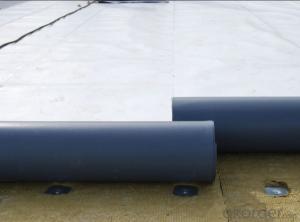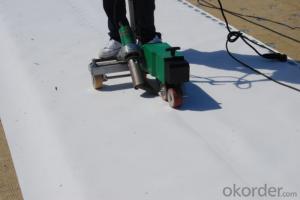TPO Waterproof Roofing Membrane Thickness with 1.8 mm
- Loading Port:
- Qingdao
- Payment Terms:
- TT OR LC
- Min Order Qty:
- 5000 m²
- Supply Capability:
- 10000 m²/month
OKorder Service Pledge
OKorder Financial Service
You Might Also Like
Description Of TPO membrane:
TPO (Thermoplastic Polyolefin) waterproof membrane is typically based on polypropylene and EP (ethylene-propylene) rubber. TPO mainly contains carbon atoms and hydrogen atoms and doesn’t contain any plasticizers and chlorine elements. It is a beautiful, long-lived eco-friendly product. TPO membranes are installed mechanically-attached, fully-adhered or ballasted.
Specification of TPO membrane:
1) Size: 2.05m (width)*20m (length) or customized
2) Thickness: 1.2mm, 1.5mm, 2.0mm
3) Type: Homogeneous; Reinforced with Polyester felt; Fabric backing
4) Color: white/grey or customized
5) Note: exposed type
Product Advantages of TPO membrane:
1. Weather resistance and durability; Excellent weld ability;
2. No any crisp agents to prevent materials brittleness;
3. Intermediate enhanced polyester mesh fabric to have high tensile strength, fatigue resistance and penetrating resistance suitable for mechanically attached roofing systems;
4. Excellent the same high and low temperature resistance as rubber materials which can keep flexible at -50° C and keep mechanical strength in high temperature;
Applications of TPO membrane:
1. Roof construction & steel structure of both industrial and civil engineering
2. Underground engineering, such as subways, tunnels, air Raid shelter, etc.
3. Sewage treatment, dam, reservoir and basement, grain storehouse, etc.
FAQ:
Q: Can I visit your company?
A: Yes, welcome to visit our enterprise.
Q: Can I do the third party testing before loading?
A: Yes, we could accept the third party testing.
Q: Which kind of payment in your company?
A: We could accept TT, LC at sight, etc.
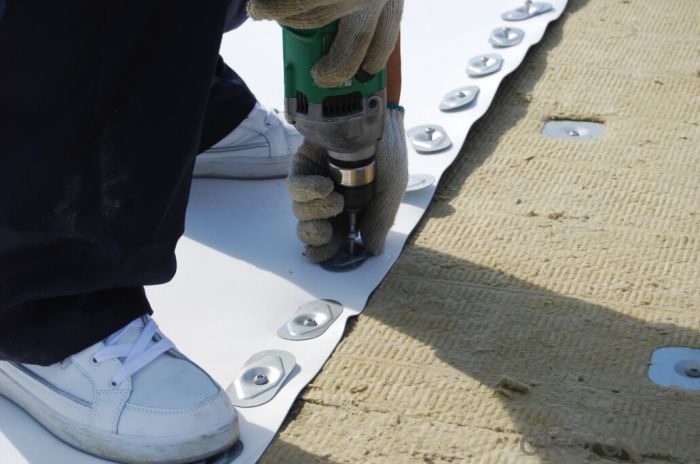
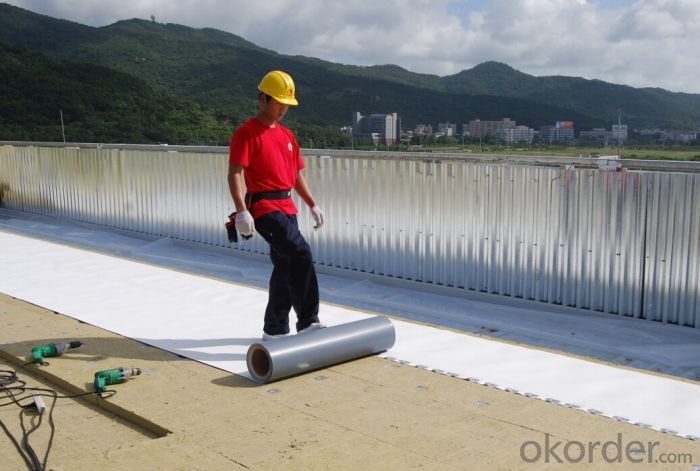

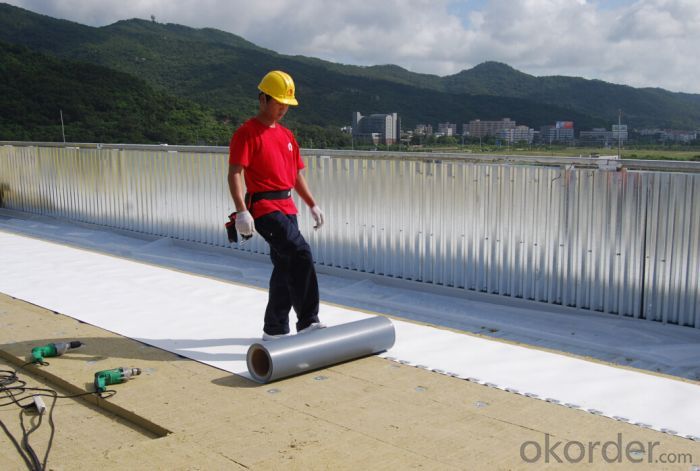
- Q:Is the waterproofing membrane an insulating material?
- There are many varieties of coil, the vast majority of the coil itself is insulated, mainly refers to the rubber, resin, asphalt. But the following are non-insulated: 1, PSS metal waterproofing membrane, which is the only coil in the whole metal coil, but the strict sense should not be included in the waterproofing membrane;
- Q:Can a waterproofing membrane be used in areas with high groundwater levels?
- Certainly, it is possible to utilize a waterproofing membrane in regions with elevated groundwater levels. In truth, it is strongly advised to employ a waterproofing membrane in such areas to safeguard the integrity of the edifice from water penetration. The primary purpose of a waterproofing membrane is to construct a barrier that hinders the ingress of water into the building or structure. This becomes particularly crucial in zones with high groundwater levels due to the substantial pressure exerted by the water, which heightens the chances of water damage or flooding. By implementing a waterproofing membrane, you can effectively minimize the risk of water infiltration and ensure the long-lasting resilience of the structure.
- Q:Can a waterproofing membrane be used on metal block surfaces?
- Yes, a waterproofing membrane can be used on metal block surfaces. Waterproofing membranes are designed to create a barrier against water and moisture, and they can be applied to a variety of surfaces, including metal. The membrane will adhere to the metal surface, creating a waterproof layer that helps prevent water infiltration and protect the metal from rusting or corrosion. However, it is important to ensure that the metal surface is clean, dry, and properly prepared before applying the waterproofing membrane to ensure proper adhesion and effectiveness. Additionally, it is recommended to consult with a professional or refer to the manufacturer's instructions for specific guidance on using a waterproofing membrane on metal block surfaces.
- Q:Can a waterproofing membrane be used on concrete bridges?
- Yes, a waterproofing membrane can be used on concrete bridges. Waterproofing membranes are commonly used to protect concrete structures, including bridges, from water damage. These membranes are applied on the surface of the concrete to create a barrier that prevents water infiltration. They are designed to be durable, flexible, and resistant to various environmental conditions. The use of a waterproofing membrane on concrete bridges can help extend their lifespan by preventing water from corroding the reinforcement steel and causing structural damage. Additionally, it can also help to prevent the formation of cracks and spalling due to freeze-thaw cycles. Overall, the application of a waterproofing membrane is an effective solution to protect concrete bridges and enhance their durability.
- Q:What are the benefits of using a waterproofing membrane?
- There are several benefits of using a waterproofing membrane, especially in construction projects or areas that are exposed to moisture or water. Firstly, a waterproofing membrane helps to prevent water penetration, which is crucial in protecting the structural integrity of a building or infrastructure. Water can seep through cracks or joints, causing damage to the foundation, walls, or floors. By applying a waterproofing membrane, it creates a barrier that prevents water from infiltrating and causing potential structural issues. Secondly, waterproofing membranes can help to prevent the growth of mold and mildew. Moisture and excess water can create a breeding ground for mold, which not only damages the aesthetics of a space but also poses health risks. By using a waterproofing membrane, it keeps moisture out and reduces the chances of mold growth, creating a healthier and safer environment. Additionally, a waterproofing membrane can help to increase the lifespan of a structure. By preventing water intrusion, it protects the building materials from deterioration caused by moisture. This can save on repair and maintenance costs in the long run, as the structure remains in good condition for a longer period of time. Furthermore, waterproofing membranes can also contribute to energy efficiency. By sealing off any gaps or cracks, it helps to retain heat or cool air inside a building, reducing energy consumption and improving insulation. This can lead to significant energy savings and lower utility bills. Lastly, using a waterproofing membrane can provide peace of mind. Knowing that a building or structure is protected from water damage, mold growth, and potential structural issues brings a sense of security and confidence, particularly in areas prone to heavy rainfall, flooding, or high moisture levels. In conclusion, the benefits of using a waterproofing membrane are numerous. It protects against water damage, prevents mold growth, increases the lifespan of a structure, improves energy efficiency, and provides peace of mind. Whether it is for residential, commercial, or industrial purposes, incorporating a waterproofing membrane is a wise investment that ensures the longevity and durability of a building or infrastructure.
- Q:Can a waterproofing membrane be used for a dam?
- Yes, a waterproofing membrane can be used for a dam. A waterproofing membrane is a material that is specifically designed to prevent the passage of water. It is commonly used in construction to create a barrier against water intrusion. In the case of a dam, which is a large structure built to hold back water and create a reservoir, it is essential to have an effective waterproofing system to prevent any leakage or seepage of water. A waterproofing membrane can be applied to the surface of the dam to provide an additional layer of protection against water penetration. The membrane is typically made of materials such as rubber, PVC, EPDM, or bitumen, which have excellent water resistance properties. It is installed in multiple layers to ensure a strong and durable barrier against water. The membrane is specifically designed to withstand the high water pressure exerted by the reservoir behind the dam. By using a waterproofing membrane, the dam's integrity can be maintained, ensuring that water does not leak through the structure and cause damage to the surrounding areas. It also helps to prevent erosion and seepage, which can weaken the dam over time. In conclusion, a waterproofing membrane can indeed be used for a dam, providing an effective solution to ensure the dam's watertightness and structural stability.
- Q:Can a waterproofing membrane be used in showers and wet areas?
- Yes, a waterproofing membrane can be used in showers and wet areas. Waterproofing membranes are designed to provide a protective barrier against water penetration, making them ideal for use in areas that are constantly exposed to water, such as showers and wet areas.
- Q:Can waterproofing membranes be used on concrete pipes?
- Yes, waterproofing membranes can be used on concrete pipes. Waterproofing membranes are commonly used to prevent water penetration and protect concrete structures from moisture damage. Concrete pipes, like any other concrete structure, are susceptible to water infiltration, which can lead to deterioration and reduced lifespan. Applying a waterproofing membrane to concrete pipes can help to create a barrier against water and prevent potential issues such as leaks, cracks, and corrosion. The membrane is typically applied to the exterior of the pipe, forming a protective layer that prevents water from seeping into the concrete. This can help to extend the lifespan of the pipes and ensure their long-term durability.
- Q:How does a waterproofing membrane handle construction joints?
- A waterproofing membrane is designed to provide a protective barrier against water penetration in construction applications. When it comes to construction joints, which are commonly found in concrete structures, the membrane is specifically engineered to handle these areas. During the construction process, joints are created to allow for movement between different sections of the structure. These joints can be vulnerable points where water can potentially infiltrate. To address this concern, waterproofing membranes are installed to ensure that these joints remain watertight. There are different methods used to handle construction joints with waterproofing membranes. One common approach is to apply the membrane directly over the joint, extending it beyond the joint edges. This creates a continuous waterproof layer that covers both the joint and the adjoining areas. Another technique involves the use of specially designed joint tapes or strips that are embedded within the membrane. These tapes or strips are typically made of materials like rubber or PVC and are placed directly over the joint before the membrane is applied. They serve as an additional layer of protection, enhancing the waterproofing performance of the membrane at the joint. In addition to these methods, there are also specialized waterproofing systems available that include pre-formed joint sealants. These sealants are designed to fit snugly into the joint, providing a tight seal against water intrusion. The membrane is then installed over the joint, ensuring comprehensive waterproofing coverage. Overall, a waterproofing membrane is specifically designed to handle construction joints by providing a durable and effective barrier against water penetration. Whether through extending the membrane over the joint, using joint tapes or strips, or incorporating pre-formed joint sealants, these membranes ensure that construction joints remain watertight, protecting the structure from potential water damage.
- Q:Can a waterproofing membrane be used in mining or excavation projects?
- Yes, a waterproofing membrane can be used in mining or excavation projects. Waterproofing membranes are designed to prevent the penetration of water or other liquids, making them suitable for protecting underground structures, tunnels, or mining areas from water ingress. They can help to maintain the stability and integrity of the excavation site, preventing water-related damages and ensuring safety.
1. Manufacturer Overview |
|
|---|---|
| Location | |
| Year Established | |
| Annual Output Value | |
| Main Markets | |
| Company Certifications | |
2. Manufacturer Certificates |
|
|---|---|
| a) Certification Name | |
| Range | |
| Reference | |
| Validity Period | |
3. Manufacturer Capability |
|
|---|---|
| a)Trade Capacity | |
| Nearest Port | |
| Export Percentage | |
| No.of Employees in Trade Department | |
| Language Spoken: | |
| b)Factory Information | |
| Factory Size: | |
| No. of Production Lines | |
| Contract Manufacturing | |
| Product Price Range | |
Send your message to us
TPO Waterproof Roofing Membrane Thickness with 1.8 mm
- Loading Port:
- Qingdao
- Payment Terms:
- TT OR LC
- Min Order Qty:
- 5000 m²
- Supply Capability:
- 10000 m²/month
OKorder Service Pledge
OKorder Financial Service
Similar products
New products
Hot products
Related keywords
